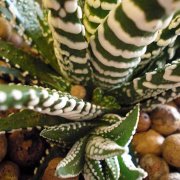Care of the succulent plant Haworthia attenuata or Zebra plant |
|
The genus Haworthia, family Asphodelaceae, comprises 100 species of succulent plants native to southern Africa. Some species are: Haworthia attenuata, Haworthia angustifolia, Haworthia limifolia, Haworthia retusa, Haworthia pumila, Haworthia fasciata, Haworthia cooperi, Haworthia arachnoidea, Haworthia variegata, Haworthia cuspidata, Haworthia viscosa, Haworthia marumiana, Haworthia reinwardtii, Haworthia turgida, Haworthia herbacea, Haworthia truncata. Common names: Zebra haworthia, Zebra plant. This species is native to Eastern Cape Province, South Africa. They are small succulent plants that reach 15 cm (5.9") in height. They have fleshy triangular leaves arranged in a rosette. The leaves are dark green and are lined with white lines on the outside; on the inside they have white spots in small bumps. The flowers (not very decorative) appear in clusters at the end of long stems and are tubular in shape. They bloom in spring and early summer. Zebra plant is used as a houseplant in pots that are wider than they are deep; It's also grown in patios, terraces, balconies, and greenhouses. Haworthia attenuata needs a well-lit exposure but no direct sun. The temperature should not be less than 10 ºC (50 ºF). The soil can be a mixture of commercial peat substrate with 20% coarse sand. The transplant is done in spring. Zebra haworthia needs little watering in spring, summer and fall (more or less every 15 days); do not water in winter. Haworthia attenuata does not need pruning or fertilizers. Zebra plant is a sensitive plant to excess humidity. Haworthia attenuata propagates from the suckers produced by the mother plant. |
Images of the succulent plant Haworthia attenuata or Zebra plant |
Find plants
Haworthia attenuata or Zebra plant | Care and Growing
© 2026 FavThemes


